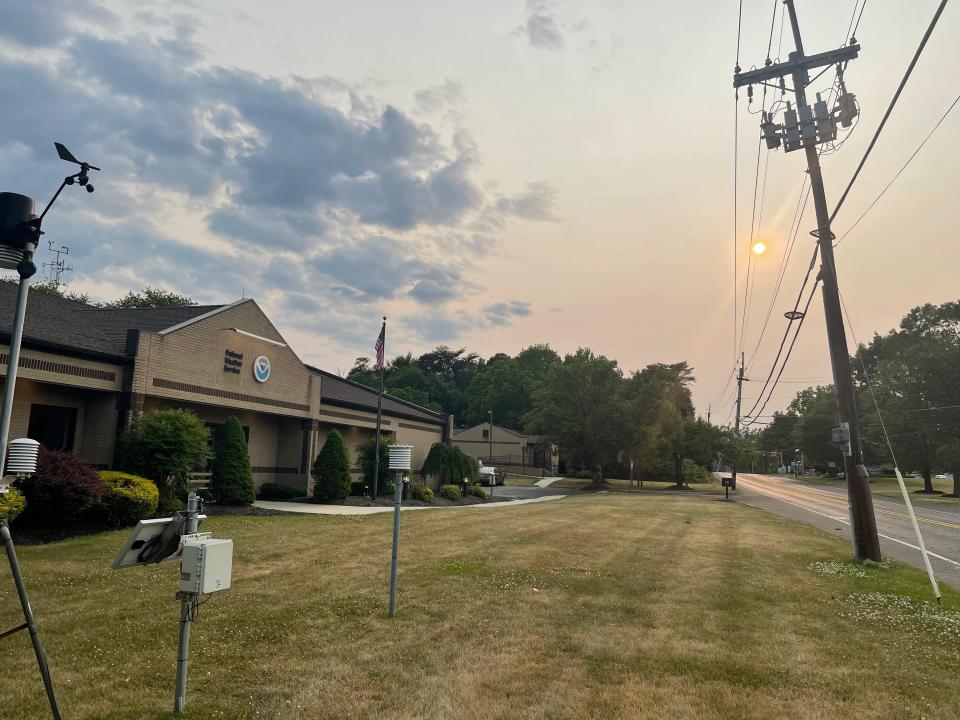Why is the sun red today? Wildfire smoke from Canada causes air quality alert for Northeast
Much of the Northeast will be under under air quality alerts this week as wildfire smoke from the north reaches the area.
The National Weather Service in Mount Holly, New Jersey said Tuesday will be hazy, warm and breezy with poor air quality due to smoke from the Canadian wildfires.

Here's why you might be seeing red this week:
Wildfire and smoke: See what areas of the US are experiencing wildfires or seeing smoke
Why is the sun red today?
Millions of Americans are exposed to unsafe air quality levels as Eastern Canada experiences one of its worst reported wildfires. Many are seeing the reddish sun this morning due to the smoke.
It certainly is other worldly outside. pic.twitter.com/Z7lMHuBycE
— Mike Stanislaw (@mikestanislaw) June 6, 2023
More than 6.7 million Canadian acres have already burned in 2023, federal officials announced last week, marking one of the worst starts to wildfire season. Around 14,000 people were forced to evacuate Quebec with over 150 fires, CBC News reported. Officials said firefighters contained a wildfire in Nova Scotia on Sunday but that another one was still burning out of control covering nearly 100 square miles, according to the Associated Press.
Americans from the Midwest and the Northeast received alerts about the air quality in their areas, particularly warning “sensitive groups” such as older adults, children or those with pre-existing respiratory conditions like asthma.
The sun this am over Brooklyn. What is this? #sunrise #nyc #redsun pic.twitter.com/JNTO5g7hfq
— Lauren (@Laurenmcfly142) June 6, 2023
The health risk of air pollution caused by wildfire smoke continues to worsen. The number of people who experienced at least one day with unhealthy air quality because of smoke increased over 27 times over the last decade, according to a Stanford University research study published last fall.
Air pollution can cause inflammation, weakens someone’s immune system and can increase the risk of asthma, lung cancer or other chronic lung diseases.
Air quality: National Weather Service issues air quality alert Wednesday due to fire in Nova Scotia
Wildfires: Smoke, haze impact US air quality as Canadian wildfires continue to rage
What is the weather today?
Delaware
The Delaware's Department of Natural Resources and Environmental Control issued a code orange air quality action day for Tuesday.
As a cold front gradually departs the First State, northwesterly winds will develop. This will allow dense smoke from eastern Canadian wildfires to enter the state, increasing particle levels and enhancing ozone formation, according to the DNFEC.
On Wednesday, a code red will be in effect as westerly to northwesterly winds will persist and weaken, transporting additional dense smoke into the state and allowing pollutants to accumulate, according to the DNFEC. Carryover of smoke from the previous day will be high, they said.
Haze from smoke from Canadian wildfires are spreading back into the Northeast and Mid-Atlantic. Hazy skies will persist through at least Tuesday. You can find Air Quality alerts on our website:https://t.co/WQeQE93E9t pic.twitter.com/timME1daPl
— NWS Mount Holly (@NWS_MountHolly) June 5, 2023
A red warning is when some members of the general public may experience health effects from poor air quality; members of sensitive groups may experience more serious health effects in these conditions, according to the DNFEC.
By Thursday, northwesterly winds will strengthen and aid dispersion but winds will continue to transport smoke into Delaware, keeping particle levels elevated.
Pennsylvania
In Pennsylvania, the state Department of Environmental Protection has issued a code orange air quality alert Tuesday for the Lehigh Valley and Berks County area.
A code orange air quality alert means that air pollution concentrations within the region may become unhealthy for sensitive groups, including children, the elderly and those who suffer from asthma, heart disease or other lung diseases, according to the NWS. The effects of air pollution can be minimized by avoiding strenuous activity or exercise outdoors.
What is a red flag warning?
A Red Flag Warning is when warm temperatures, very low humidifies and stronger winds are expected to combine to produce an increased risk of fire danger.
⚠️🔥 A combination of gusty winds, low relative humidity, and dry fuel moistures are forecast today. Any fires that develop may quickly get out of control and become difficult to contain. Here are some wildfire prevention and safety tips. #PAwx #NJwx #DWwx #MDwx pic.twitter.com/pFpxYmuQ5u
— NWS Mount Holly (@NWS_MountHolly) June 6, 2023
On Tuesday, the NWS issued a red flag warning through 8 p.m. for Southeastern Pennsylvania including areas of the Lehigh Valley and Poconos as well most of New Jersey as low moistures and daytime humidity as well as breezy conditions will result in critical fire weather conditions. Any fires that develop may quickly get out of control and become difficult to contain, they said.
There is also a chance of isolated dry thunderstorms, which could serve as an ignition source for fires today, according to the NWS.
A highly unusual scenario supporting wildfire spread is possible today across parts of the Northeast. Dry/breezy surface conditions and dry thunderstorms are possible this afternoon. Gusty, erratic winds may also accompany the storms, further aggravating fire conditions. pic.twitter.com/Wt9nIJ6ncm
— NWS Storm Prediction Center (@NWSSPC) June 6, 2023
This article originally appeared on Delaware News Journal: Why is the sun red? NWS issues air quality alert from Canada wildfires

